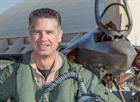Training to Fly the Lightning II: A Test Pilot’s Perspective
In his earliest childhood memories, Andrew “Bundy” Soundy knew he wanted to be a pilot. From his childhood in the U.K., to his days in the Canadian Forces (CF) to his current role as a civilian test pilot for Lockheed Martin, Soundy has always had his hand in the aviation world. After all, this is to be expected of a man who held a pilots’ license before he could drive a car.
A Seasoned Pilot
Growing up in the U.K., Soundy flew with the Air Training Corps (ATC) until he moved to Canada at age sixteen. After flying two operations in the CF-18 for the Canadian Forces, he assisted the U.S. Navy with a radar development program for that particular jet. He then did a stint flying operationally for two years with the U.S. Marine Corps via an exchange program—when he decided to go through U.S. Navy test pilot school (USNTPS). After graduating from USNTPS, he began flying F-16s on exchange for the U.S. Air Force.
After returning to the CF to finish out the last of his CF-18 work and retire from the service, Soundy dabbled in commercial test pilot work before landing at Lockheed Martin as an F-16 test pilot and newly minted U.S. citizen in 2010.
Now, he is adding the F-35 to his impressive list of nearly 50 aircraft types that he has flown.
In July 2014, Soundy became the first-ever civilian pilot to graduate from the F-35 training school at Eglin Air Force Base (AFB), Florida. As someone who has quite literally seen the evolution of airplanes, he cannot hide his excitement about the Lightning II.
“For a pilot, this is the cutting edge of fighter aviation right now. It is the leading edge—the latest and greatest,” he explains. “This airplane is going to be around for a very long time, and it is great to be involved with it early on.”
“Putting On” An F-35
Soundy describes the way the F-35 handles in one word: exceptional. He maintains that the F-35’s systems are so seamlessly integrated; flying the aircraft is a pilot’s dream.
“Flying the F-35 is beyond just flying an airplane,” he says. “When I climb into this jet, I don’t get into it—I put it on.”
This is due in part to the next generation technology in the pilot’s helmet, which eliminates the traditional heads up display found in fourth generation fighters. When he puts on the helmet, Soundy can only compare it to the feeling of being completely in sync with something—the jet essentially becomes an extension of you.
“At the end of the day, all the parts of the airplane integrate so well, that is the best part about flying it,” he reveals. “You don’t have to think about flying the airplane, and you can focus more on the mission at hand.”
This integration encompasses sensor fusion—a trait unique to fifth generation aircraft—which Soundy understands front-to-back thanks to his degree in electrical engineering. He explains the major difference with the F-35 is that it brings all of that integration and more in terms of stealth, sensors, fusion and its ability to share data with a sophisticated networking capability.
“It does everything in a very polished and complete manner because it was designed that way from day one,” he affirms.
International Flavor
Soundy’s diverse background as a pilot for two foreign countries and all three of the U.S. services planning to use the F-35 gives him a unique understanding of the needs of every program stakeholder.
“I have flown with and lived in a lot of the main countries that are going to be operating this aircraft, so I bring that background in terms of aircraft development on a daily basis,” he elaborates.
Most importantly, Soundy underscored the unprecedented impact the F-35 program will have on global aerospace defense. He recognizes that we live in a time where it truly pays to work together, and the F-35 enables us to do just that.
“We are strongest as a coalition. This airplane was built with the international flavor of the program in mind. The way it is designed, it is designed to integrate seamlessly,” he explains.
“Our warfighters need to be able to do that to fly effectively—not as a single country, but as a coalition of world partners.”

